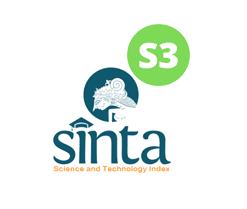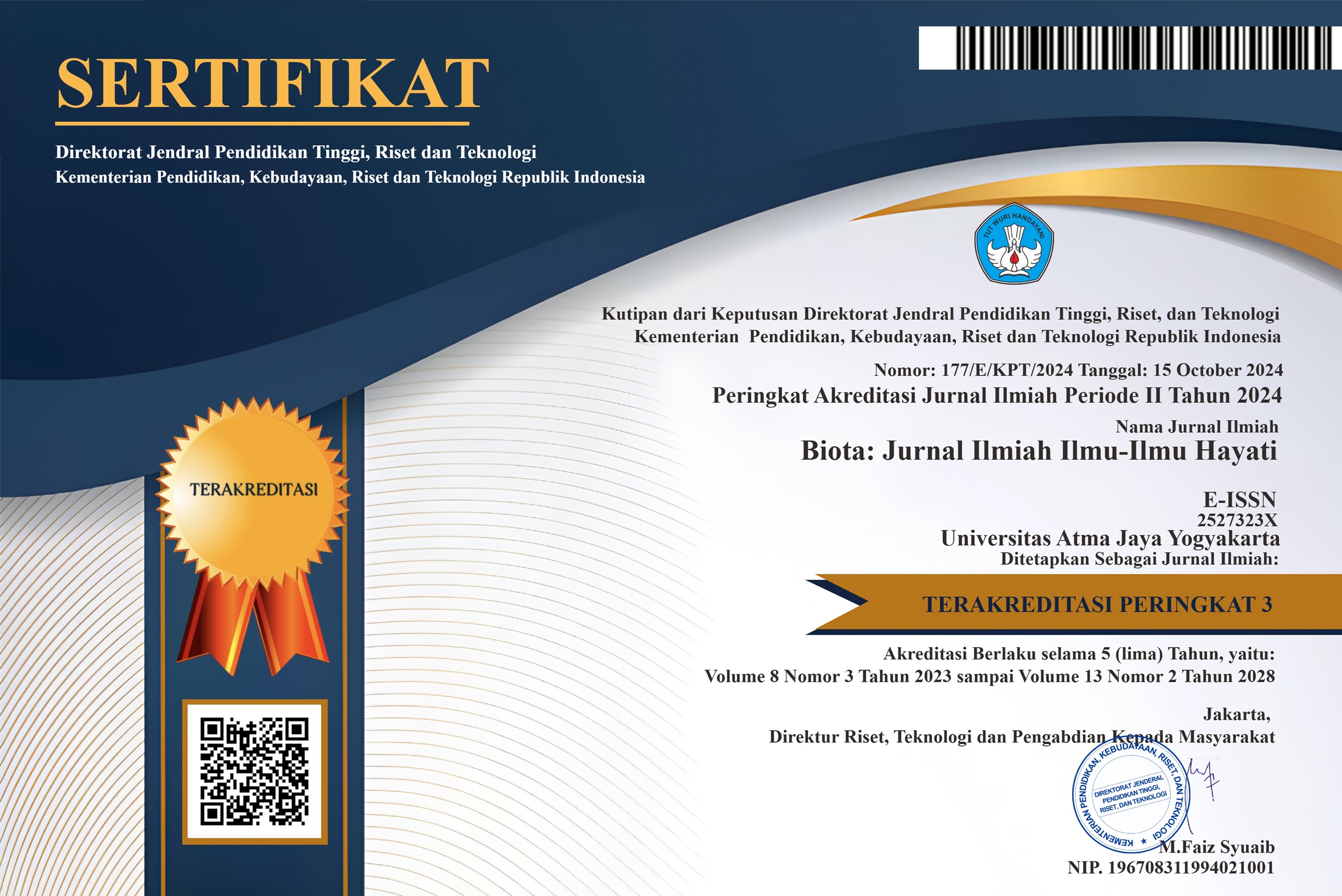Isolasi dan Karakterisasi Lactobacillus Species dari Susu Kambing Peternakan Lokal
DOI:
https://doi.org/10.24002/biota.v8i3.6718Keywords:
Bakteri asam laktat, Lacticaseibacillus paracasei, Limosilactobacillus fermentum, susu kambing, 16S rRNA sequencingAbstract
Mikrobiota susu kambing dapat mencakup bakteri asam laktat (BAL), khususnya Lactobacillus spp., yang berpotensi sebagai kandidat probiotik dan dapat dipergunakan dalam berbagai produk fermentasi. Pada penelitian ini, dilakukan isolasi dan karakterisasi BAL, khususnya Lactobacillus spp., dari susu kambing yang berasal dari peternakan lokal. Pada awalnya, didapatkan 25 isolat BAL dari susu kambing lokal. Semua isolat dikarakterisasi sesuai Bergey’s Manual of Systematics Archaea and Bacteria, yang dimulai dengan pewarnaan Gram, endospora dan ketahanan asam. Selanjutnya dilakukan uji aktivitas biokimia (uji aktivitas katalase, uji aktivitas hemolitik, serta uji fermentasi karbohidrat) dan uji ketahanan isolat terhadap berbagai konsentrasi NaCl, pH dan suhu. Berdasarkan hasil yang diperoleh, isolat B4 dan B6 dipilih untuk diidentifikasi lebih lanjut. Kedua isolat menunjukkan kemiripan karakteristik dengan Lactobacillus spp., yaitu berbentuk basil atau kokobasil, Gram positif, tidak membentuk spora, tidak tahan asam, katalase negatif, tidak memfermentasi manitol, sensitif terhadap konsentrasi NaCl tinggi, serta tumbuh optimum pada pH 5.5-6.2 dan pada suhu 37-45°C. Identifikasi kedua isolat berdasarkan sekuens 16S rRNA menunjukkan bahwa isolat B4 adalah Lacticaseibacillus paracasei dan isolat B6 adalah Limosilactobacillus fermentum. Sebagai kesimpulan, penelitian ini menunjukkan bahwa susu kambing peternakan lokal dapat menjadi sumber alternatif untuk mendapatkan isolat Lactobacillus spp.
References
Ahirwar, S., Gupta, M., Gupta, G. & Singh, V. (2017). Screening, isolation and identification of Lactobacillus species from dental caries of children. International Journal of Current Microbiology and Applied Sciences 6(1): 497-503.
Anindita, N. S., Anwar, M. & Taufiq, T. T. (2017). Ketahanan isolat bakteri asal feses bayi terhadap variasi susu dan pH [Bachelor’s thesis]. Universitas ‘Aisyiyah.
Badis, A., Guetarni, D., Moussa-Boudjemâa, B., Henni, D. E., Tornadijo, M. E., & Kihal, M. (2004). Identification of cultivable lactic acid bacteria isolated from Algerian raw goat’s milk and evaluation of their technological properties. Food Microbiology 21(3): 343–349.
Bazireh, H., Shariati, P., Azimzadeh Jamalkandi, S., Ahmadi, A. & Boroumand, M. A. (2020). Isolation of novel probiotic Lactobacillus and Enterococcus strains from human salivary and fecal sources. Frontiers in Microbiology 11: 597946.
Bin Masalam, M. S., Bahieldin, A., Alharbi, M. G., Al-Masaudi, S., Al-Jaouni, S. K., Harakeh, S. M., & Al-Hindi, R. R. (2018). Isolation, Molecular Characterization and Probiotic Potential of Lactic Acid Bacteria in Saudi Raw and Fermented Milk. Evidence-based complementary and alternative medicine : eCAM 2018: 7970463.
Budinich, M., Perez-Díaz, I., Cai, H., Rankin, S. A., Broadbent, J. R. & Steele, J. L. (2011). Growth of Lactobacillus paracasei ATCC 334 in a cheese model system: a biochemical approach. Journal of Dairy Science 94(11): 5263-5277.
Chotiah, S. & Damayanti, R. (2018). Karakterisasi bakteri asam laktat kandidat probiotik untuk mengatasi Salmonelosis pada ayam pedaging. Bulletin Plasma Nutfah 24(2): 91-98.
Da Silva, L. A., Lopes Neto, J. H. P., & Cardarelli, H. R. (2019). Safety and probiotic functionality of isolated goat milk lactic acid bacteria. Annals of Microbiology 69(13): 1497–1505.
De Angelis, M. & Gobbetti, M. (2011). Lactic acid bacteria Lactobacillus spp. general characteristics. In P. McSweeney & J. McNamara (Eds.), Encyclopedia of Dairy Sciences 3rd edition. Academic Press: Cambridge, UK.
Dempsey, E. & Corr, S. C. (2022). Lactobacillus spp. for Gastrointestinal Health: Current and Future Perspectives. Frontiers in Immunology 13: 840245.
Dewi, A. K. (2013). Isolasi, Identifikasi dan uji sensitivitas Staphylococcus aureus terhadap Amoxicillin dari sampel susu kambing Peranakan Ettawa (PE) penderita mastitis di wilayah Girimulyo, Kulonprogo, Yogyakarta. Jurnal Sain Veteriner 31(2): 138-150.
Febriana, M. H., Purwijantiningsih, E. & Yuda, P. (2021). Identifikasi dan uji aktivitas antimikrobia bakteri asam laktat dari fermentasi singkong (Gatto) terhadap Bacillus cereus dan Aspergillus flavus. Biota: Jurnal Ilmiah Ilmu-Ilmu Hayati 6(1): 15-24.
Firmansyah, D., Herawati, I. & Fauziah, P. (2021). Aktivitas antimikroba Lactobacillus sp. yang diisolasi dari feses bayi terhadap pertumbuhan bakteri Salmonella typhi. Anakes: Jurnal Ilmiah Analisis Kesehatan 7(1): 16-24.
Hammes, W. P. & Hertel, C. (2015). Lactobacillus. In W. B. Whitman (Ed.), Bergey's Manual of Systematics of Archaea and Bacteria. Springer: New York, USA.
Hernández-Saldaña, O. F., Valencia-Posadas, M., de la Fuente-Salcido, N. M., Bideshi, D. K., & Barboza-Corona, J. E. (2016). Bacteriocinogenic Bacteria Isolated from Raw Goat Milk and Goat Cheese Produced in the Center of México. Indian Journal of Microbiology 56(3): 301–308.
Hill, D., Sugrue, I., Tobin, C., Hill, C., Stanton, C., & Ross, R. P. (2018). The Lactobacillus casei group: history and health related applications. Frontiers in Microbiology 9:2107
Hodgkinson, A. J., McDonald, N. A., Kivits, L. J., Hurford, D. R., Fahey, S., & Prosser, C. (2012). Allergic responses induced by goat milk αS1-casein in a murine model of gastrointestinal atopy. Journal of Dairy Science 95(1): 83–90.
Ibrahim, S. A. (2016). Lactic acid bacteria: Lactobacillus spp.: Other species. Food Science 125–131.
Islam, R. , Hossain, M. , Alam, M. , Uddin, M. , Rony, M. , Imran, M. and Alam, M. (2020) Antibacterial Activity of Lactic Acid Bacteria and Extraction of Bacteriocin Protein. Advances in Bioscience and Biotechnology, 11, 49-59. doi: 10.4236/abb.2020.112004.
Leoney, A., Karthigeyan, S., Asharaf, A. S. & Felix, A. J. W. (2020). Detection and categorization of biofilm-forming Staphylococcus aureus, Viridans streptococcus, Klebsiella pneumoniae, and Escherichia coli isolated from complete denture patients and visualization using scanning electron microscopy. Journal of International Society of Preventive & Community Dentistry 10(5): 627–633.
Marroki, A., Zúñiga, M., Kihal, M., & Pérez-Martínez, G. (2011). Characterization of lactobacillus from Algerian goat's milk based on phenotypic, 16S rdna sequencing and their technological properties. Brazilian Journal of Microbiology, 42(1): 158–171.
Mega, O., Jahidin, J. P., Sulaiman, N. B., Yusuf, M., Arifin, M., & Arief, I. I. (2020). Total count of lactic acid bacteria in goats and cows milk yoghurt using starter S. thermophilus RRAM-01, L. Bulgaricus RRAM-01 and L. Acidophilus IIA-2B4. Buletin Peternakan, 44(1): 50–56.
Naghmouchi, K., Belguesmia, Y., Bendali, F., Spano, G., Seal, B. S., & Drider, D. (2019). Lactobacillus fermentum: A bacterial species with potential for food preservation and biomedical applications. Critical Reviews in Food Science and Nutrition 60(20): 3387–3399.
Pakroo, S., Tarrah, A., Takur, R., Wu, M., Corich, V., & Giacomini, A. (2022). Limosilactobacillus fermentum ING8, a Potential Multifunctional Non-Starter Strain with Relevant Technological Properties and Antimicrobial Activity. Foods (Basel, Switzerland) 11(5): 703.
Prosser, C. G. (2021). Compositional and functional characteristics of goat milk and relevance as a base for infant formula. Journal of Food Science 86(2): 257–265.
Ratya, N., Taufik, E., & Arief, I. I. (2017). Karakteristik Kimia, Fisik dan Mikrobiologis Susu Kambing Peranakan Etawa di Bogor. Jurnal Ilmu Produksi dan Teknologi Hasil Peternakan 5(1): 1-4.
Ruiz Rodríguez, L. G., Mohamed, F., Bleckwedel, J., Medina, R., De Vuyst, L., Hebert, E. M. & Mozzi, F. (2019). Diversity and functional properties of lactic acid bacteria isolated from wild fruits and flowers present in northern Argentina. Frontiers in Microbiology 10: 1–12.
Tajabadi, N., Mardan, M., Saari, N., Mustafa, S., Bahreini, R. & Manap, M. Y. (2013). Identification of Lactobacillus plantarum, Lactobacillus pentosus and Lactobacillus fermentum from honey stomach of honeybee. Brazilian Journal of Microbiology 44(3): 717–722.
Talib, N., Mohamad, N. E., Yeap, S. K., Hussin, Y., Aziz, M. N. M., Masarudin, M. J., Sharifuddin, S. A., Hui, Y. W., Ho, C. L. & Alitheen, N. B.. (2019). Isolation and characterization of Lactobacillus spp. from kefir samples in Malaysia. Molecules 24(14): 2606.
Tannock G. W. (2004). A special fondness for Lactobacilli. Applied and environmental microbiology 70(6): 3189–3194.
Triana, E. & Nurhidayat, N. (2007). Seleksi dan identifikasi Lactobacillus kandidat probiotik penurun kolesterol berdasarkan analisis sekuen 16s RNA. Biota: Jurnal Ilmiah Ilmu-Ilmu Hayati 12(1): 55-60.
Yanis, N. P. H. & Agustin, T. P. (2020). Overview of the total bacteria and number of Streptococcus mutans in the saliva of children with high caries activity. Journal of Indonesian Dental Association 3(1): 1-5.
Downloads
Published
How to Cite
Issue
Section
License
Copyright (c) 2023 Cindy Octaviana, Medista Lisa Watumbara, Marcelia Sugata, Juandy Jo

This work is licensed under a Creative Commons Attribution-NonCommercial 4.0 International License.
Authors who publish with Biota : Jurnal Ilmiah Ilmu-Ilmu Hayati agree to the following terms:
- Authors retain copyright and grant the Biota : Jurnal Ilmiah Ilmu-Ilmu Hayati right of first publication. Licensed under a Creative Commons Attribution-NonCommercial 4.0 International License that allows others to share the work with an acknowledgment of the work's authorship and initial publication in this journal.
- Authors are able to enter into separate, additional contractual arrangements for the non-exclusive distribution of the journal's published version of the work (e.g., post it to an institutional repository or publish it in a book), with an acknowledgment of its initial publication in Biota : Jurnal Ilmiah Ilmu-Ilmu Hayati, and as long as Author is not used for commercial purposes.













